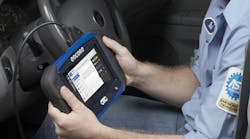The technology in today’s vehicles is growing at a rapid pace and these complex systems require more advanced tools and equipment. But my experience in the vehicle service and repair industry has led me to believe we are spending more time and money on advanced tools and not enough on the people who must use them.
I agree we need advanced equipment. However, technicians must be able to utilize this equipment it in a way that allows them to get valuable diagnostic information, and to make the right decision for accurate and efficient repair of the vehicle.
I believe a tool is only as good as the hands that use it.
Resource Spending
Some technicians and shops spend a tremendous amount of resources to research and test scan tools and other equipment prior to making a purchase or upgrading. The intent of those decisions is to allow technicians to install, repair or adjust whatever it is they are working on faster, easier or with greater accuracy.
Do we spend the same amount of energy and resources on effectively training those using these tools on the various vehicle systems?
It takes a million plus dollars to build a modern racecar, and we don’t just stick an untrained driver in it to win races. There is always a fully trained driver in the driver’s seat.
Think about the complex systems your technicians will be plugging a scan tool into. Are they completely trained, beyond training that focuses on the tool and its features and benefits? I mean the training given to the technicians on the systems these tools will be used on.
There is a difference between just knowing how to use the tool and knowing what tests and information the tool can provide for diagnostics.
Training should be about the technician understanding and comprehending the data and information the scan tool is able to show them.
Trouble Codes
When the “service light” comes on in your car, what is your first thought? Is it to take the car to the local dealership, repair shop or parts store? Some believe: Why pay a technician to retrieve the code and replace a part or make a repair when I can go to the parts store and have the part-time parts guy bring out a code reader, retrieve the code, go back in the store, type in my vehicle and proceed to tell me the possible parts that can fix it?
How many times has one of your technicians replaced a “known good” part, and replaced it more than once? Manufacturers and suppliers continuously talk about the high percentage of parts returned with nothing wrong.
Retrieving a code is truly the smallest function a scan tool provides. It’s what you do with that code and the additional functions of the scan tool and other support – such as a meter and service information – that make the difference. It’s knowing the gaps and diagnostic methods that tools and service information may or may not have.
Service information can be a great tool for a trained technician. But for the untrained, it can be a nightmare.
Foundational Skills
I believe a good understanding of the systems – theory and operation – you plan to use the scan tool for is essential to accurately diagnosing and repairing today’s vehicles. I refer to this understanding as foundational skills. Foundational skills allow the technician to make solid diagnostic conclusions rather than guess.
Whether it’s brakes, transmissions, engines or others systems, there are sensors that range from potentiometers to the piezoelectric effect to thermistors to A/C generators. We know them as throttle position, knock, coolant temperature and speed sensors.
What’s important, is how these sensors communicate with the modules and whether the technician understands this. Has training been provided for the technicians on the systems scan tools will be used on?
For example, you install Microsoft Office on a computer and ask someone to use it. They now have such applications as Word, Excel, Outlook and PowerPoint.
The question is: Do they know the full capabilities of these applications and how they can be used to make work easier, or do they just use the basic functions and leave most of the capabilities these applications have untouched? It’s likely the latter.
Self Examination
In conclusion, I feel we should all do a self-evaluation and decide if we are spending our resources in the correct manner. Specialty tools and equipment can be counterproductive unless technicians can use them to diagnose systems correctly the first time.
Knowing the information needed to diagnose a vehicle and finding it is the key. Sometimes the technician with the biggest toolbox in the shop cannot fix the smallest concern on a vehicle.
Don’t go down the same path we did on the automotive side when we started utilizing scan tools. Invest in the best tools for your shop and your technicians, along with the best training.
Let’s learn from history and not make the same costly decisions. In today’s repair environment, Mike Delaney, president and CEO, WheelTime Network, said it best: “You have to know, not think.”
George Arrants is director of training and recruitment for the WheelTime Network (www.wheeltime.com), North America’s largest dedicated service and parts network for quality truck and coach care, and its WheelTime University (WTU). WTU provides assessments, training and ASE (Automotive Service Excellence) test preparation for WheelTime member technicians and fleets that may not have their own training program. It has instructor-led courses to support and enhance the online training. As an Automotive Education Consultant specializing in National Automotive Technicians Education Foundation (NATEF)/ASE Accreditation, Arrants works with instructors and administrators to develop partnerships with local business and industry through program advisory committees. These committees help schools establish, develop and maintain programs that are relevant to the needs of automotive, medium and heavy duty and collision industries and the community. He chairs the Technology and Maintenance Council’s TMCSuperTech – the National Technician Skills Competition – and the TMCFutureTech – the National Student Technician Competition. His entire career has been in the automotive service and education industries.




